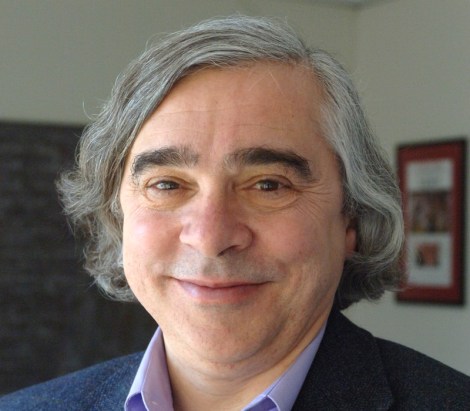Everyone is excited about rumors that President Obama will name Ernest Moniz to run the Department of Energy. Reactions range from “Who is Ernest Moniz?” to “What happened to the other guy?” to “Who was the other guy?”
Well, we are here to answer those questions! (The first one, anyway; we’ve answered the other two before.) Since you live a fast-paced lifestyle, always on the go, we’ve broken it up into bite-sized pieces, one bit of info at a time. You are welcome in advance.
Who is Ernest Moniz?
Well, he might be the next secretary of energy — if Obama nominates him and if the Senate approves him. It is possible that in two months time he will be of very little interest to you, having not been confirmed. Or he will be of very little interest to you because he was confirmed, but you, like most Americans, are fairly indifferent to the office of secretary of energy.
But you knew that. So here’s who he is, as articulated by Reuters, which appears to have been first with rumors of his imminent nomination.
Moniz, a former undersecretary of energy during the Clinton administration, is director of the Massachusetts Institute of Technology’s Energy Initiative, a research group that gets funding from industry heavyweights including BP, Chevron, and Saudi Aramco for academic work on projects aimed at reducing greenhouse gases.
Ha ha. Sounds great! We will come back to this part, obviously.
At MIT, Moniz led intensive studies about the future of coal, nuclear energy and natural gas, and he helped attract funding and research momentum to energy projects on campus.
People familiar with Moniz’s work said, if chosen, he would bring his own energy and pragmatism to the job. …
Moniz earned kudos for a pragmatic approach toward using research to find ways to reduce carbon pollution from fossil fuels and transition to cleaner forms of energy.
We’ll come back to this, too.
What does he look like?
Well, he looks like this:
But more evocatively, he kind of looks like a Founding Father who teaches high-school English in New Hampshire.
Has he ever been in any movies?
No. According to IMDB, he’s only ever been on Frontline. Put those autograph books away!
What’s his actual, non-summarized background?
Here’s part of his bio at MIT:
Professor Moniz received a Bachelor of Science degree summa cum laude in physics from Boston College, a doctorate in theoretical physics from Stanford University, and honorary doctorates from the University of Athens, the University of Erlangen-Nurenburg, and Michigan State University. He was a National Science Foundation Postdoctoral Fellow at Saclay, France, and at the University of Pennsylvania. Professor Moniz is a Fellow of the American Association for the Advancement of Science, the Humboldt Foundation, and the American Physical Society and a member of the Council on Foreign Relations. He received the 1998 Seymour Cray HPCC Industry Recognition Award for vision and leadership in advancing scientific simulation and, in 2008, the Grand Cross of the Order of Makarios III for contributions to development of research, technology and education in Cyprus and the wider region.
(Honestly, “the Grand Cross of the Order of Makarios III” sounds made up.)
I would like to hear him in his own words, please.
Fine. Here you go, via Switch Energy Project, as pointed out to us by D. Ray Long.
How do environmental groups feel about his possible nomination?
A charitable way to describe how they feel would be: mixed.
As noted above, his program at MIT receives a lot of money from fossil fuel interests. And Moniz has been unabashed in his advocacy of the use of natural gas as a “bridge” fuel and even for some expansion of nuclear power. (You can read his thoughts on the latter here.)
The Hill has a small collection of quotes from disaffected greens, but the better overview comes from Inside Climate News, which has a good article on Moniz’s background. It starts with his thoughts on natural gas.
In December, while speaking at the University of Texas at Austin, Moniz warned that while natural gas could reduce carbon emissions by displacing coal-fired electricity, its increasing use could also slow growth in the clean energy sector.
“When it comes to carbon, [natural] gas is part of our solution at least for some time,” said Moniz, who served as undersecretary of energy during the Clinton administration. “And we should take advantage of the time to innovate and bring down the cost of renewables. The worst thing w[ould] be is to get time and not use it. And that I’m afraid is where we are.”
This isn’t incorrect, mind you — natural gas has spurred a drop in carbon emissions and is certainly going to be part of the mix. But it’s not something that most environmental organizations are currently championing, especially given the process usually used to extract that gas: fracking.
Moniz has accepted fracking as a necessary-but-unnecessarily-polluting evil. In 2011, Moniz presented a report from his MIT group to the Senate, saying:
“Regulation of shale (and other oil and gas) activity is generally controlled at the state level, meaning that acceptable practices can vary between shale plays,” Moniz wrote in his prepared testimony. “The MIT study recommends that in order to minimize environmental impacts, current best practice regulation and oversight should be applied uniformly to all shales.”
Moniz didn’t elaborate on how to standardize regulations and oversight …
“Prior to carrying out our analysis, we had an open mind as to whether natural gas would indeed be a ‘bridge’ to a low-carbon future,” he told the committee. “In broad terms, we find that, given the large amounts of natural gas available in the U.S. at moderate cost … natural gas can indeed play an important role over the next couple of decades (together with demand management) in economically advancing a clean energy system.”
At the same time, however, the report projected that natural gas will “eventually become too carbon intensive” and should be phased out around 2050.
Moniz’s record also demonstrates commitment to renewable energy development.
As a member of the President’s Council of Advisors on Science and Technology, he helped write a 2010 report that recommended a federal investment of $16 billion per year for clean energy innovation — about triple the 2010 investment. Some of that money could come from the private sector, the report said. For example, “we use about 200 billion gallons of transportation fuel annually, so a two cents per gallon charge would … generate about $4 billion per year.” It said the same amount of money could be raised by charging a fee for the electricity used nationwide — a suggestion Moniz reiterated at the Texas conference.
Expect this to come up during confirmation hearings.
So, will he be confirmed by the Senate?
Well, given the drawn-out, ridiculous path Republican Chuck Hagel has been forced to crawl in his bid to be secretary of defense, God only knows. Granted, defense is a more high-profile Cabinet position, but it seems clear that his nomination happened under the belief that confirmation would be easier than it has been.
And, of course, Moniz would first have to be nominated.
OK. So, will he be nominated?
As before: God only knows. Well, God and Obama.




